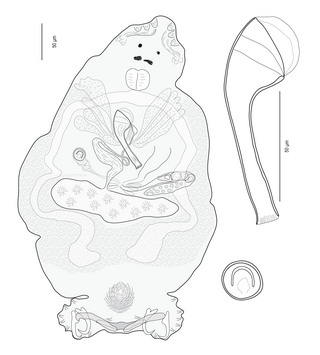
Pseudorhabdosynochus is a genus of monopisthocotylean monogeneans, included in the family Diplectanidae. The type-species of the genus is Pseudorhabdosynochus epinepheli .

The Diplectanidae are a family of monopisthocotylean monogeneans. They are all parasitic on the gills of fish. Diplectanids are small animals, generally around 1 mm in length. As parasites, they can be extremely numerous, up to several thousand on an individual fish.
Calydiscoides is a genus of monopisthocotylean monogeneans, included in the family Diplectanidae.

Pseudorhabdosynochus manifestus is a diplectanid monogenean parasite first found in host Epinephelus malabaricus near Nouméa, between its secondary gill lamellae. It can infest its host by the hundreds. It was ascribed that name because it was the most abundant species found while its descriptive study was taking place. As appreciated from studying juvenile specimens, the development of female organs precedes that of male organs in this species and is likely the case in other Pseudorhabdosynochus species.
Pseudorhabdosynochus huitoe is a diplectanid monogenean parasitic on the gills of the highfin grouper, Epinephelus maculatus. It was described in 2007.

Pseudorhabdosynochus caledonicus is a diplectanid monogenean parasitic on the gills of the Blacktip grouper, Epinephelus fasciatus. It has been described in 2005.

Ancyrocephalidae is a family of monogenean flatworms. The family is considered as a "temporary name" in WorMS but includes a large number of genera and species.
Pennulituba is a genus of monogeneans belonging to the family Ancyrocephalidae.
Volsellituba is a genus of monogeneans belonging to the family Ancyrocephalidae.

Laticola is a genus of monopisthocotylean monogeneans, belonging to the family Diplectanidae. All known species are parasitic on the gills of marine fish, including members of Lates (Latidae) and Epinephelus (Serranidae).
Pseudorhabdosynochus exoticus is a species of diplectanid monogenean that is parasitic on the gills of the blue grouper Epinephelus cyanopodus. It was described in 2008.

Laticola dae is a species of diplectanid monogenean. It is parasitic on the gills of the Highfin grouper, Epinephelus maculatus. It was described in 2006. The species is a member of the genus Laticola Yang, Kritsky, Sun, Zhang, Shi & Agrawal, 2006. More than 400 specimens of this parasite were studied for the description of the species, which was the most abundant monogenean species, representing about 50% of the specimens found on this fish.
Echinoplectanum chauvetorum is a species of diplectanid monogenean parasitic on the gills of the black-saddled coralgrouper, Plectropomus laevis. It has been described in 2006.
Echinoplectanum leopardi is a species of diplectanid monogenean parasitic on the gills of the leopard coralgrouper, Plectropomus leopardus. It has been described in 2006.
Echinoplectanum pudicum is a species of diplectanid monogenean parasitic on the gills of the leopard coralgrouper, Plectropomus leopardus. It has been described in 2006. This species was distinguished from all other species of the genus Echinoplectanum by the shape and small size of its male copulatory organ, and the apparent absence of a sclerotised vagina.
Echinoplectanum rarum is a species of diplectanid monogenean parasitic on the gills of the leopard coralgrouper, Plectropomus leopardus. It has been described in 2006. This species is very rare and represented only 2% of the specimens of Echinoplectanum spp. found in P. leopardus. This species was distinguished from other species of the same genus by its characteristic ring-shaped sclerotised vagina.
Pseudorhabdosynochus cupatus is a species of diplectanid monogenean parasitic on the gills of groupers.
Pseudorhabdosynochus youngi is species of diplectanid monogenean parasitic on the gills of the blacktip grouper, Epinephelus fasciatus. It was described in 2009.
Pseudorhabdosynochus melanesiensis is a diplectanid monogenean parasitic on the gills of the grouper, Epinephelus merra. It was described in 1958 as Diplectanum melanesiensis then transferred to the genus Pseudorhabdosynochus by Kritsky & Beverley-Burton in 1986.
Pseudorhabdosynochus vagampullum is a species of diplectanid monogenean parasitic on the gills of a grouper. It was described in 1969, from eight specimens, under the name Diplectanum vagampullum and transferred to the genus Pseudorhabdosynochus in 1986. The species has been redescribed several times.




